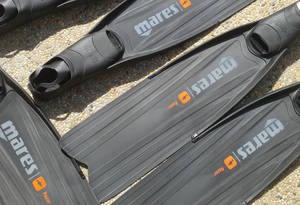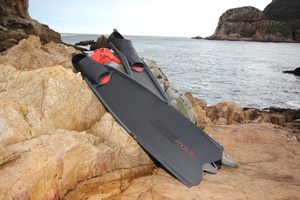- You are here:
- Home »
- Blog »
- Gear Guide »
- What freediving fins angle should you be using?
What freediving fins angle should you be using?


You know for a fact that angular fins facilitate your diving. But when searching for a pair of quality fins, you notice that angled freediving fins are sometimes cheaper than their non-angled counterparts. This makes you doubt if the angle is a good thing and what the best freediving fins angle is.
A freediving fins angle can range from 0 to 30+ degrees, but choosing the right angle depends on your flexibility, diving expertise, technique, and water depth among other things. As a rule of thumb, stick to 20-24 degrees. Surface divers and individuals with less flexibility may need lower angles.
Read on to learn why manufacturers make freediving fins angled. You’ll also learn about the pros and cons of these fins and find out what the best angle for your specific needs is.
Angular Fins vs. Flat Fins
Angled fins have gained huge popularity among divers and manufacturers alike because they all agree on their superiority over non-angled models.
For starters, think of the position of your feet while at rest. Your toes aren’t in line with the direction of your legs, but rather, they have an upward, almost perpendicular angle. Similarly, when you glide through the ocean with your face down, your feet will bend downwards rather than remaining horizontal behind you.
This makes you try harder to keep your feet straight, battling with your body’s natural physiology. As a result, you may put more strain on your ankles, calves, and tibia, compromising your diving efforts.
But when there’s an angle between your foot and the fin blade, this natural curve turns into a more linear, flexible shape which delivers more propulsion to your feet and makes your finning easier.
What’s the Standard Fin Angle?
Most diving fins have an angle of 12 to 27 degrees, with some newer models going over 30. However, although a fin angle results in better thrust power, it’s not always like the bigger the better.
The standard fin angle is between 20 to 24 degrees. This range results in fast propulsion, minimum fatigue, and lower energy requirement for finning. Nevertheless, choosing the best angle also depends on your ankle flexibility, kicking technique, and diving depth.
We’ll later discuss each factor in detail.
Why You Need a Proper Angle
The wider the angle between the blades and your foot pocket, the less effort you’ll need to move through the water. That’s because the blades feel softer to you, so your foot strokes get stronger, and you feel more comfortable propelling forward.
However, this comfort comes with certain downsides.
If the angle is too wide, it makes your strokes less responsive, meaning there will be a delay between when you kick and when the blades make a move. So, you’ll progress more slowly compared to a less inclined blade.
A very wide fin angle affects your kick amplitude, meaning you have to kick wider to reach the thrust power you wish. So, since there’s always a trade-off, you should find a fin with a good balance between these factors. A 22-degree fin angle usually makes that happen.
However, the ideal degree may vary from person to person.
How To Choose the Best Fin Angle
There’s no one-size-fits-all answer to your freediving fins angle. You may want to consider the following factors to find the best match for your needs while snorkeling.
Diving Depth
When you dive close to the water surface with a snorkel, a straighter fin might be better. That’s because very wide angles twist the blade tips all the way above the surface, and produce a lot of splashing noise.
Not only that, it’ll devastate your kicking efficiency.
Yet, that doesn’t mean you have to go for a completely flat fin, as one with a 20-degree or narrower curve will usually do the trick.
Your Diving Skills
Sometimes, the fact that your fins come out of the water has nothing to do with your blade angle. Instead, your lack of proficiency or flexibility makes that happen. To check if that’s true about you, perform a quick test by following the steps below:
1. Sit on the ground with your bare feet and lay them in front of you.
2. Then stretch your toes downward as far as you can to see if they touch the floor.
If your toes reach the floor, your kicking technique has no flaws, and you should probably go for a less curved fin to keep them underwater.
But if you’re not even close to a 180-degrees downward rotation, or at least, your feet must maintain a horizontal state, if not completely pointed down, you’ll need to improve your skills rather than the fins.
Why Monofins Might Be Better
Resembling the dolphin’s flipper, monofins enclose both of your feet next to each other so that you can’t kick them independently.
These fins are mostly used for deep diving, weight freediving, straight-line diving, and any underwater sport that requires extra power with each kick. So, they’re intentionally made to weigh less than bi-fins.
On the other hand, monofins can’t be angled in the blade because of their flipper-like appearance. So, manufacturers put an extra layer of neoprene inside their foot pocket to shape that angle.
And since a wider angle means thicker neoprene, they keep the angle to a minimum.
So, if you wish to use a monofin in your freediving session, stick to those with lower angles.
Most often, a degree of 20 would suffice.
Gliding Technique
When gliding, you need more force to fin through the ocean, so you should prioritize easier propulsion. It means higher blade angles are better, even if they compromise your kicking reactivity.
Most 30-plus degree fins are geared toward this technique.
Best Freediving Fins With the Right Angle
Now that you know the best fin angle for your needs, it’s time to find the best freediving fin. Here are a few suggestions available on Amazon.com:
Mares Razor Freediving Fins
Engineered by an Italian foot clinic, this freediving fin ensures you’ll have relaxed feet while diving for extended periods. At only 2 lbs (0.91 kg), it’s one of the lightest fins you can get on the market.
And that lightweight doesn’t come at the cost of angle or blade length. You’ll get a pair of 22-degree blades, 36” (91.44 cm) long. The Technopolymer material and neoprene socks also make it super durable, which is great for its price.

Click here to read our review of the Mares Razor freediving fins.
Seac Motus Freediving Fins
With a 22-degree blade angle, Seac Motus is a great combination of comfortability, speed, and reactivity. It features interchangeable blades, so you can change your blade style whenever you want or even match it with blades from other brands.
Also, the rigid thermoplastic rubber foot pocket and ribbing make it pretty resistant. If you’re a beginner to intermediate freediver, this can be your best bet.

To learn more read our full review of the Seac Motus fins.
Leaderfins Pure Carbon Fiber Freediving Fins
Leaderfins Pure Carbon Fiber is the best option for advanced freedivers as it nails the performance and comfort factors. Its 1 mm (0.04”) neoprene makes it super lightweight, and its soft EPDM insoles make them easy on your feet.
The blades are a combo of epoxy resin and carbon fiber, that although fragile, emphasize your agility. These fins come with a universal blade degree of 20.
Final Verdict
The standard freediving fins angle lies between 20-24 degrees, but you can also find fins with as low as 0 and as high as 35-degree angles. So, it’s all up to you to choose your best fit among them.
Freediving fins with wider angles are usually more comfortable, efficient, and flexible. But remember not to go too high as you may risk your speed. Besides, don’t choose too tilted monofins as they’re heavier. Choose above 30 degrees only for gliding purposes.
If you break the water surface with a bent blade, do some workouts to enhance your feet’s flexibility.
About the Author Gerrie van Niekerk - Apnealogy
Gerrie is a passionate Freediver, Spearfisher, Digital Marketer, and author for the Apnealogy website. Gerrie is an SSI Level 1 certified Freediver who loves geeking out about freediving and spearfishing gear and lives for his family and adventure.

